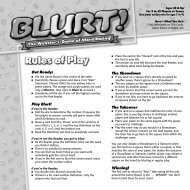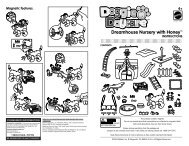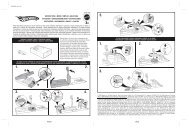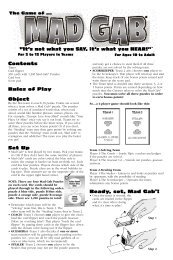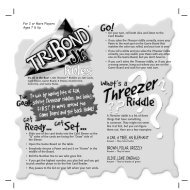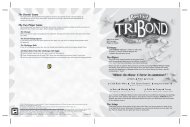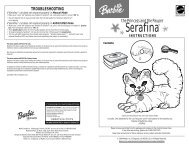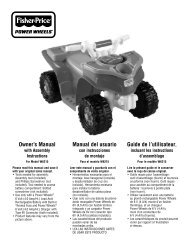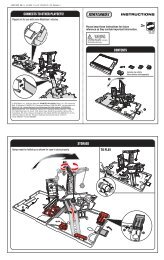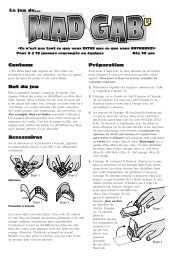L7821 : Power Wheels Nascar - Mattel
L7821 : Power Wheels Nascar - Mattel
L7821 : Power Wheels Nascar - Mattel
You also want an ePaper? Increase the reach of your titles
YUMPU automatically turns print PDFs into web optimized ePapers that Google loves.
Owner's Manual<br />
with Assembly<br />
Instructions<br />
For Model <strong>L7821</strong><br />
Please read this manual and save it<br />
with your original sales receipt.<br />
Tools needed for assembly:<br />
Phillips Screwdriver (not included) and Assembly<br />
Tool (included). Use only with a <strong>Power</strong> <strong>Wheels</strong> ®<br />
12 Volt Rechargeable Battery and <strong>Power</strong> <strong>Wheels</strong> ®<br />
12 Volt Charger with Type 12V connector<br />
(both included).<br />
Product features may vary<br />
from the picture above.
A<br />
A<br />
2<br />
Your new vehicle requires adult assembly. Please set aside at least<br />
30 minutes for assembly.<br />
You must charge your battery for 18 - 30 hours before you use your<br />
vehicle for the first time. We recommend that you start charging<br />
your battery before beginning assembly. Please see Battery Charging<br />
beginning on page 6 for detailed instructions.<br />
Read this manual carefully for important safety information and<br />
operating instructions before using your vehicle. Keep this manual<br />
for future reference as it contains important information.<br />
This vehicle is designed for use on: concrete, grass, asphalt and<br />
other hard surfaces; on generally level terrain; and by children<br />
3 years of age and older.<br />
This vehicle has been pre-set so it will only operate in low speed.<br />
See the instructions on page 15 to remove the high speed<br />
lock-out screw.<br />
Use this vehicle ONLY outdoors. Most interior flooring can be<br />
damaged by riding this vehicle indoors. Fisher-Price ® will not be<br />
responsible for damage to the floor if the vehicle is used indoors.<br />
To prevent damaging the motors and gears, teach your child to<br />
stop the vehicle before switching direction. Do not tow anything<br />
behind the vehicle or overload it. Do not exceed the maximum<br />
weight capacity of 65 lbs (29.5 kg).<br />
TABLE OF CONTENTS<br />
A Important Information . . . . . . . . . . . . . . . . . . . . . . . . . . . . . . . . . . . . . . . . . . . . . . . . . . . . . . . . . . . . . . . . . . . . . . . . . . . . . . . . . . . . . . . . . . . . . 2<br />
B Warnings and Cautions . . . . . . . . . . . . . . . . . . . . . . . . . . . . . . . . . . . . . . . . . . . . . . . . . . . . . . . . . . . . . . . . . . . . . . . . . . . . . . . . . . . . . . . . . . . 3<br />
C Parts . . . . . . . . . . . . . . . . . . . . . . . . . . . . . . . . . . . . . . . . . . . . . . . . . . . . . . . . . . . . . . . . . . . . . . . . . . . . . . . . . . . . . . . . . . . . . . . . . . . . . . . . . 4<br />
D Parts Picture . . . . . . . . . . . . . . . . . . . . . . . . . . . . . . . . . . . . . . . . . . . . . . . . . . . . . . . . . . . . . . . . . . . . . . . . . . . . . . . . . . . . . . . . . . . . . . . . . . . 5<br />
E Battery Charging. . . . . . . . . . . . . . . . . . . . . . . . . . . . . . . . . . . . . . . . . . . . . . . . . . . . . . . . . . . . . . . . . . . . . . . . . . . . . . . . . . . . . . . . . . . . . . . . . 6<br />
F Assembly . . . . . . . . . . . . . . . . . . . . . . . . . . . . . . . . . . . . . . . . . . . . . . . . . . . . . . . . . . . . . . . . . . . . . . . . . . . . . . . . . . . . . . . . . . . . . . . . . . . . . . 7<br />
G Vehicle Care . . . . . . . . . . . . . . . . . . . . . . . . . . . . . . . . . . . . . . . . . . . . . . . . . . . . . . . . . . . . . . . . . . . . . . . . . . . . . . . . . . . . . . . . . . . . . . . . . . . 9<br />
H Decoration. . . . . . . . . . . . . . . . . . . . . . . . . . . . . . . . . . . . . . . . . . . . . . . . . . . . . . . . . . . . . . . . . . . . . . . . . . . . . . . . . . . . . . . . . . . . . . . . . . . . . 10<br />
I Battery Installation . . . . . . . . . . . . . . . . . . . . . . . . . . . . . . . . . . . . . . . . . . . . . . . . . . . . . . . . . . . . . . . . . . . . . . . . . . . . . . . . . . . . . . . . . . . . . . 12<br />
J Battery Care and Disposal . . . . . . . . . . . . . . . . . . . . . . . . . . . . . . . . . . . . . . . . . . . . . . . . . . . . . . . . . . . . . . . . . . . . . . . . . . . . . . . . . . . . . . . . 13<br />
K Safe Driving Rules . . . . . . . . . . . . . . . . . . . . . . . . . . . . . . . . . . . . . . . . . . . . . . . . . . . . . . . . . . . . . . . . . . . . . . . . . . . . . . . . . . . . . . . . . . . . . . 14<br />
L Vehicle Operation . . . . . . . . . . . . . . . . . . . . . . . . . . . . . . . . . . . . . . . . . . . . . . . . . . . . . . . . . . . . . . . . . . . . . . . . . . . . . . . . . . . . . . . . . . . . . . . 15<br />
M Problems and Solutions Guide. . . . . . . . . . . . . . . . . . . . . . . . . . . . . . . . . . . . . . . . . . . . . . . . . . . . . . . . . . . . . . . . . . . . . . . . . . . . . . . . . . . . . 16<br />
N Limited Warranty. . . . . . . . . . . . . . . . . . . . . . . . . . . . . . . . . . . . . . . . . . . . . . . . . . . . . . . . . . . . . . . . . . . . . . . . . . . . . . . . . . . . . . . . . . . . . . . . 19<br />
IMPORTANT INFORMATION<br />
If you have any questions about your <strong>Power</strong> <strong>Wheels</strong> ® vehicle,<br />
please call our toll-free service lines at 1-800-348-0751 from<br />
9 AM to 7 PM (EST) Monday through Friday and 11 AM to 5 PM<br />
(EST) Saturday. Trained customer service representatives are<br />
available to take your call in English or French. Habla Español? Si<br />
usted tiene alguna pregunta ó necesita asistencia llame gratis<br />
1-800-348-0755 para los Estados Unidos. Tenemos representantes<br />
que hablan español para atender su llamada.<br />
For your convenience, <strong>Power</strong> <strong>Wheels</strong> ® maintains an independently<br />
owned and operated Authorized Service Center Network with more<br />
than 300 authorized service centers nationwide. Our authorized<br />
service centers will repair or replace parts under warranty at no extra<br />
charge, and can perform non-warranty repairs for a minimal charge.<br />
To find the authorized service center nearest you, please visit us<br />
on-line at www.powerwheels.com or call 1-800-348-0751.<br />
To register your vehicle, please visit us on-line at<br />
www.powerwheels.com.<br />
<strong>L7821</strong>pr-0920<br />
L7822pr-0920
ELECTRICAL HAZARD<br />
<strong>L7821</strong>pr-0920<br />
WARNINGS AND CAUTIONS B<br />
Battery can fall out and injure a child if vehicle tips over. Always use battery retainer.<br />
PREVENT FIRE<br />
- Never modify the electrical system. Alterations could cause a fire resulting in serious injury<br />
and could also ruin the electrical system.<br />
- Use of the wrong type battery or charger could cause a fire or explosion resulting in<br />
serious injury.<br />
- Use of <strong>Power</strong> <strong>Wheels</strong> ® components in products other than <strong>Power</strong> <strong>Wheels</strong> ® vehicles could<br />
cause overheating, fire or explosion.<br />
The battery must be handled by adults only. The battery is heavy and contains sulfuric acid<br />
(electrolyte). Dropping the battery could result in serious injury.<br />
Never allow children to charge the battery. Battery charging must be done by adults only. A child<br />
could be injured by the electricity involved in charging the battery.<br />
Read the safety instructions on the battery.<br />
Examine the battery, charger and their connectors for excessive wear or damage each time<br />
you charge the battery. If damage or excessive wear is detected, do not use the charger or the<br />
battery until you have replaced the worn or damaged part.<br />
HOT motors. Handle carefully.<br />
RIDING HAZARD<br />
WARNING<br />
WARNING<br />
Prevent Injuries and Deaths<br />
Direct Adult Supervision Required<br />
Never Ride at Night.<br />
Keep Children Within Safe Riding Areas.<br />
These areas must be:<br />
- away from swimming pools and other bodies of water to prevent drownings<br />
- generally level to prevent tipovers<br />
- away from steps, steep inclines, cars, roads and alleys.<br />
Riding Rules<br />
Make sure children know and follow these rules for safe driving and riding.<br />
- Always sit on the seat.<br />
- Always wear shoes.<br />
- Only 1 (one) rider at a time.<br />
CAUTION<br />
In the unassembled state, this package contains small parts. Adult assembly is required.<br />
Use the charger in dry locations only.<br />
L7822pr-0920 3
C<br />
4<br />
PARTS<br />
If you experience a problem with this product, or are missing a part, please call us at 1-800-348-0751, rather than return this product<br />
to the store.<br />
Please identify all parts before assembly and save all packaging material until assembly is complete to ensure that no parts are discarded.<br />
Metal parts have been coated with a lubricant to protect them during shipment. Wipe all metal parts with a paper towel to remove any<br />
excess lubricant.<br />
Vehicle<br />
Steering Wheel Cover<br />
Assembly Tool<br />
Front Bumper<br />
Steering Wheel<br />
Steering Column<br />
Part not shown: Label Sheet<br />
12 Volt Battery<br />
12 Volt Charger<br />
#8 x 3/4" Screw - 6<br />
3/8" -16 Lock Nut - 2<br />
For your convenience, we included extra fasteners!<br />
Note: Tighten and loosen all screws with a Phillips screwdriver.<br />
Do not over-tighten the screws.<br />
Fasteners Shown Actual Size<br />
<strong>L7821</strong>pr-0920<br />
L7822pr-0920
<strong>L7821</strong>pr-0920<br />
5<br />
1<br />
PARTS PICTURE D<br />
8<br />
1 Vehicle<br />
2 Steering Column<br />
3 Steering Wheel<br />
4 Steering Wheel Cover<br />
5 Front Bumper<br />
6 12 Volt Charger<br />
7 12 Volt Battery<br />
8 3/8" - 16 Lock nut<br />
8<br />
#8 x 3/4" Screw - 6<br />
Label Sheet<br />
Assembly Tool<br />
2<br />
Parts Not Shown<br />
4<br />
3<br />
6<br />
7<br />
5
E<br />
BATTERY CHARGING<br />
ELECTRICAL HAZARD<br />
WARNING CAUTION<br />
Battery can fall out and injure a child if<br />
vehicle tips over. Always use battery<br />
retainer.<br />
PREVENT FIRE<br />
- Never modify the electrical system.<br />
Alterations could cause a fire resulting<br />
in serious injury and could also ruin the<br />
electrical system.<br />
- Use of the wrong type battery or charger<br />
could cause a fire or explosion resulting<br />
in serious injury.<br />
- Use of <strong>Power</strong> <strong>Wheels</strong> ® components in<br />
products other than <strong>Power</strong> <strong>Wheels</strong> ®<br />
vehicles could cause overheating, fire<br />
or explosion.<br />
The battery must be handled by adults only.<br />
The battery is heavy and contains sulfuric<br />
acid (electrolyte). Dropping the battery<br />
could result in serious injury.<br />
Never allow children to charge the battery.<br />
Battery charging must be done by adults<br />
only. A child could be injured by the electricity<br />
involved in charging the battery.<br />
Read the safety instructions on the battery.<br />
Examine the battery, charger and their<br />
connectors for excessive wear or damage<br />
each time you charge the battery. If<br />
damage or excessive wear is detected, do<br />
not use the charger or the battery until you<br />
have replaced the worn or damaged part.<br />
Use the charger in dry locations only.<br />
About Thermal Fuses<br />
Your <strong>Power</strong> <strong>Wheels</strong> ® 12 volt battery is equipped with a built-in<br />
thermal fuse. The thermal fuse is a self-resetting safety device<br />
which automatically “trips” and shuts down operation of the vehicle<br />
if the vehicle is overloaded or the driving conditions too severe.<br />
Once a fuse has “tripped”, remove your foot from the pedal and wait<br />
approximately 25 seconds before operating the vehicle again. To<br />
avoid repeated automatic shut-downs, do not overload the vehicle by<br />
exceeding the 65 lb. (29.5 kg) maximum weight capacity or by towing<br />
anything behind the vehicle. Avoid severe driving conditions, such as<br />
driving up slopes or running into fixed objects, which can cause the<br />
wheels to stop spinning while power is still being supplied to<br />
the motors and make sure your child stops the vehicle before<br />
switching direction.<br />
If a thermal fuse in a battery continually trips under normal driving<br />
conditions, please contact your local <strong>Power</strong> <strong>Wheels</strong> ® Authorized<br />
Service Center. For the location of the Authorized Service Center<br />
nearest to you, visit us on-line at www.powerwheels.com,<br />
or call 1-800-348-0751.<br />
Important Notes<br />
Your new battery must be charged for at least 18 hours before<br />
you use it in your vehicle for the first time.<br />
We recommend that you start charging your battery before<br />
beginning assembly of your new vehicle.<br />
The battery must be upright while charging.<br />
The charger is not a toy.<br />
Do not short circuit the battery.<br />
You do not need to remove the battery from your vehicle to<br />
recharge it.<br />
Before charging the battery, examine the battery case for cracks<br />
and other damage which may cause sulfuric acid (electrolyte) to<br />
leak during the charging process. If damage is detected, do not<br />
charge the battery or use it in your vehicle. Battery acid is very<br />
corrosive and can cause severe damage to surfaces it contacts.<br />
Do not charge the battery on a surface (such as a kitchen counter<br />
top) which could be damaged by the acid contained inside the<br />
battery. Take precautions to protect the surface on which you<br />
charge your battery.<br />
Use only a <strong>Power</strong> <strong>Wheels</strong> ® 12 volt charger with "12 V" connector<br />
(input 120 VAC, 60 Hz, 28W with an output of 12 VDC, 1200 mA)<br />
to charge your <strong>Power</strong> <strong>Wheels</strong> ® 12 volt battery.<br />
Adults Note: Regularly examine the charger for damage to the<br />
cord, plug, housing or other parts that may result in the risk of fire,<br />
electric shock or injury. In the event of any damage, do not use<br />
the charger until the damage has been properly repaired. Please<br />
call 1-800-348-0751.<br />
If your battery is old and will not accept a charge, do not leave it in<br />
the vehicle. Always remove a dead battery from the vehicle.<br />
6 <strong>L7821</strong>pr-0920
E<br />
BATTERY CHARGING ASSEMBLY F<br />
A<br />
B<br />
Charger<br />
Connector<br />
First, plug the charger connector into the battery A .<br />
Then, plug the charger into a standard wall outlet. The power<br />
indicator lights B .<br />
Notes:<br />
- The power indicator on the charger does not indicate the charge<br />
status of your battery. The power indicator allows you to see that<br />
there is power from the wall outlet.<br />
- If power flow to the wall outlet is controlled by a switch, make sure<br />
the switch is “ON”.<br />
- Use the charger only in a wall outlet. Do not plug the charger in to a<br />
ceiling outlet.<br />
Before first-time use, charge the battery for at least 18 hours.<br />
Never charge the battery longer than 30 hours.<br />
Recharge the battery for at least 14 hours after each use of your<br />
vehicle. Do not charge the battery longer than 30 hours.<br />
Once the battery is charged, disconnect the battery connector from<br />
the charger connector. Unplug the charger from the wall outlet. The<br />
battery is now ready to be installed in your vehicle. Please see the<br />
Battery Installation section on page 12 for detailed instructions on<br />
<strong>L7821</strong>pr-0920<br />
WARNING<br />
Children can be harmed by small parts,<br />
sharp edges and sharp points in the<br />
vehicle's unassembled state, or by electrical<br />
items. Care should be taken in unpacking<br />
and assembly of the vehicle. Children should<br />
not handle parts, including the battery, or<br />
help in assembly of the vehicle.<br />
1 BOTTOM VIEW<br />
Carefully lift the front end of the vehicle.<br />
Fit the front bumper to the front of the vehicle.<br />
2<br />
Front Bumper<br />
Insert four screws into the underside of the bumper and tighten.<br />
Hints:<br />
- You may need to turn the wheels to fit all four screws into<br />
the bumper.<br />
- You may need to push and pull on the bumper to align the<br />
screw holes.<br />
7
F<br />
3<br />
Lower the front end of the vehicle.<br />
Insert two screws into the front bumper and tighten.<br />
4<br />
FRONT VIEW<br />
BOTTOM VIEW<br />
Steering Column<br />
ASSEMBLY<br />
Front Bumper<br />
Steering Column<br />
Carefully lift the front end of<br />
the vehicle.<br />
Wipe the steering column with a<br />
DASH VIEW<br />
paper towel to remove any<br />
excess lubricant.<br />
Insert the straight end of the steering column through the slot in the<br />
vehicle and out through the large hole in the center of the dash.<br />
Be sure the steering column comes through the hole in the dash.<br />
5<br />
Fit the curved end of the steering column through the hole in the<br />
steering linkage.<br />
6<br />
Assembly Assembly Tool<br />
Tool<br />
Steering Steering Linkage<br />
Linkage<br />
Lock Lock Nut<br />
Nut<br />
Place the lock nut (rounded side out) onto the end of the<br />
steering column.<br />
Tighten the lock nut firmly using the closed end of the assembly tool.<br />
8 L7822pr-0920<br />
<strong>L7821</strong>pr-0920
F<br />
Assembly Tool<br />
7<br />
8<br />
<strong>L7821</strong>pr-0920<br />
ASSEMBLY<br />
Large Tab<br />
Large Slot<br />
Steering Wheel<br />
INSIDE VIEW<br />
Small Slot<br />
Lock Nut<br />
Hold the steering column in place and gently lower the vehicle.<br />
While supporting the steering column, fit the steering wheel onto the<br />
steering column.<br />
Place the lock nut (rounded side out) onto the end of the<br />
steering column.<br />
Tighten the lock nut firmly using the closed end of the assembly tool.<br />
Small Tab<br />
First, fit the large tab on the steering wheel cover into the large slot<br />
in the steering wheel.<br />
Then, insert and “snap” the small tab on the steering wheel cover<br />
into the small slot in the steering wheel.<br />
PICTURE PAGE VEHICLE CARE DG<br />
Check all screws, cap nuts and their protective coverings regularly<br />
and tighten as required. Check plastic parts on a regular basis for<br />
cracks or broken pieces.<br />
During snowy or rainy weather, the vehicle should be stored inside<br />
or under a protective cover. Remember to charge the battery at<br />
least once per month while your vehicle is not in regular use.<br />
Avoid operating the vehicle in wet or snowy conditions, and do not<br />
spray the vehicle with a hose. Do not wash the vehicle with soap<br />
and water. Water or moisture in the motors or electrical switches<br />
can cause them to corrode, and could cause switch or motor failure.<br />
Avoid operating the vehicle on sand, loose dirt or gravel. Sand,<br />
loose dirt or gravel in the motors or electrical switches can cause<br />
them to jam, and could cause switch or motor failure.<br />
The vehicle can be wiped down with a soft, dry cloth. For a shiny<br />
finish, you can wipe plastic parts with a non-wax furniture polish<br />
applied to a soft-cloth. Do not use automotive wax. Do not use<br />
soap and water or spray the vehicle with a hose.<br />
To ensure that your vehicle stays in good operating order, we<br />
recommend that you periodically have your vehicle checked by a<br />
<strong>Power</strong> <strong>Wheels</strong> ® authorized service center. For the location of the<br />
authorized service center nearest you, please visit us on-line at<br />
www.powerwheels.com or call 1-800-348-0751.<br />
9
H<br />
10<br />
Proper label application will help to keep the labels looking their best! When applying labels, keep the following guidelines in mind:<br />
Wash your hands before applying the labels.<br />
Before applying the labels, wipe the surface of the vehicle with a clean, dry cloth to remove any dust or oils.<br />
Place the labels exactly as shown in the illustrations.<br />
For best results, avoid repositioning a label once it has been applied to the vehicle.<br />
After applying a label, rub the label firmly with a clean, dry cloth to make sure the label is adhered to your vehicle.<br />
Start at the center of a label, and smooth towards the outer edges to remove air bubbles.<br />
1<br />
12<br />
16<br />
24<br />
2<br />
27<br />
17<br />
RIGHT SIDE VIEW<br />
¤<br />
9<br />
DECORATION<br />
¤<br />
6<br />
31<br />
15<br />
19<br />
13<br />
14<br />
8<br />
8<br />
14<br />
13<br />
15<br />
31<br />
5<br />
¤<br />
20<br />
9<br />
17<br />
27<br />
16<br />
¤<br />
11<br />
LEFT SIDE VIEW<br />
<strong>L7821</strong>pr-0920
3<br />
<strong>L7821</strong>pr-0920<br />
26<br />
25<br />
7<br />
22 23<br />
TOP VIEW<br />
¤<br />
DECORATION H<br />
10<br />
21<br />
4<br />
REAR VIEW<br />
28<br />
FRONT VIEW<br />
10<br />
30<br />
18<br />
29<br />
18<br />
11
I<br />
12<br />
IMPORTANT! Use only a <strong>Power</strong> <strong>Wheels</strong> ® 12 volt lead-acid<br />
rechargeable battery. Use of any other battery will damage your<br />
vehicle. Make sure that you charge the battery for at least 18<br />
hours using the enclosed <strong>Power</strong> <strong>Wheels</strong> ® 12 volt charger before<br />
operating your vehicle for the first time. Charge the battery for at<br />
least 14 hours after each use of the vehicle. Never charge the<br />
battery longer than 30 hours. Failure to follow these instructions<br />
may damage your battery and will void your warranty.<br />
1<br />
Insert the end of the assembly tool or a coin into the slot on the side<br />
of the hood.<br />
Use the tool to lift the hood and access the battery compartment.<br />
<strong>Power</strong> <strong>Wheels</strong> ®<br />
12 Volt Battery<br />
2<br />
Assembly Tool<br />
Battery Retainer<br />
Lift and pull the battery retainer forward.<br />
Plug the motor harness connector into the battery.<br />
BATTERY INSTALLATION<br />
Motor Harness Connector<br />
3<br />
Place the battery in the battery compartment and release the<br />
battery retainer. Make sure the battery retainer slides over the top of<br />
the battery.<br />
Close the hood and fit the tabs on the hood into the slots in<br />
the vehicle.<br />
Press down to "snap" the hood in place.<br />
<strong>L7821</strong>pr-0920
Care<br />
If a battery leak develops, avoid contact with the leaking acid and<br />
place the damaged battery in a plastic bag. See information below<br />
for proper disposal.<br />
If acid comes in contact with skin or eyes, flush with cool water for<br />
at least 15 minutes and call a physician.<br />
If acid is internally ingested, give water, milk of magnesia or egg<br />
whites immediately. Never give emetics or induce vomiting. Call<br />
a physician.<br />
Charge a new battery for at least 18 hours before first use.<br />
Never charge the battery longer than 30 hours. Overcharging or<br />
undercharging the battery may shorten battery life and decrease<br />
vehicle running time.<br />
After the first charge, recharge the battery for at least 14 hours<br />
after each use. Never charge the battery longer than 30 hours.<br />
Charge the battery after each use, regardless of how long the<br />
vehicle was used.<br />
The battery must be upright while charging.<br />
Do not allow the battery to run down completely before charging.<br />
Charge the battery before storing the vehicle.<br />
Charge the battery at least once per month, even if the vehicle has<br />
not been used.<br />
Leaving the battery in a discharged condition will ruin it.<br />
Always remove an exhausted battery from the vehicle. Battery<br />
leakage and corrosion can damage the vehicle.<br />
Do not store the battery on a surface (such as a kitchen counter<br />
top) which could be damaged by the acid contained inside the<br />
battery. Take precautions to protect the surface on which you store<br />
the battery.<br />
Do not store the battery in temperatures above 75° F or below -10° F.<br />
Use only a <strong>Power</strong> <strong>Wheels</strong> ® 12 volt battery. Remember to charge the<br />
new battery for at least 18 hours before first use.<br />
Prevent the battery from moving freely inside the battery compartment.<br />
Always use the battery retainer to secure the battery in<br />
the battery compartment.<br />
Examine the battery, charger and their connectors for excessive<br />
wear or damage each time you charge the battery. If damage is<br />
detected, do not use the charger or the battery until you have<br />
replaced the worn or damaged part.<br />
<strong>L7821</strong>pr-0920<br />
BATTERY CARE AND DISPOSAL J<br />
Disposal<br />
Your <strong>Power</strong> <strong>Wheels</strong> ® battery is a non-spillable, sealed lead-acid<br />
battery. It must be recycled or disposed of in an environmentally<br />
sound manner.<br />
Do not dispose of a lead-acid battery in a fire. The battery may<br />
explode or leak.<br />
Protect the environment by not disposing of this product with<br />
household waste (2002/96/EC). Check your local authority for<br />
recycling advice and facilities (Europe only).<br />
Do not dispose of a lead-acid battery in your regular, household<br />
trash. The incineration, landfilling or mixing of sealed lead-acid<br />
batteries with household trash is prohibited by law in most areas.<br />
Return an exhausted battery to a federal or state approved lead-acid<br />
battery recycler, such as a <strong>Power</strong> <strong>Wheels</strong> ® authorized service center<br />
or a local seller of automotive batteries. For the authorized service<br />
center location nearest to you, please visit us on-line at<br />
www.powerwheels.com or call 1-800-348-0751. Contact your<br />
local waste management officials for other information regarding<br />
the environmentally sound collection, recycling and disposal of<br />
lead-acid batteries. If you live in the State of Florida or the State of<br />
Minnesota, it is prohibited by law for anyone to throw away lead-acid<br />
batteries in the municipal waste stream.<br />
13
K<br />
14<br />
RIDING HAZARD<br />
WARNING<br />
Prevent Injuries and Deaths<br />
• Direct Adult Supervision Required<br />
• Never Ride at Night.<br />
• Keep Children Within Safe Riding Areas.<br />
These areas must be:<br />
- away from swimming pools and other<br />
bodies of water to prevent drownings<br />
- generally level to prevent tipovers<br />
- away from steps, steep inclines, cars,<br />
roads and alleys.<br />
• Riding Rules<br />
Make sure children know and follow<br />
these rules for safe driving and riding.<br />
- Always sit on the seat.<br />
- Always wear shoes.<br />
- Only 1 (one) rider at a time.<br />
SAFE DRIVING RULES<br />
Teach Safety Rules to Children<br />
While children can quickly develop the skill necessary to drive this<br />
vehicle, it is important to remember that their judgment skills are still<br />
very immature. Unsupervised driving by children can lead to serious<br />
injury. Before children use this vehicle, an adult should carefully<br />
evaluate the driving area as well as the children’s skill level and ability<br />
to drive this vehicle safely. Children are not always able to recognize<br />
or anticipate hazards, even when they have been taught about them.<br />
There is no acceptable substitute for direct adult supervision.<br />
Teach appropriate safety rules to your child before allowing operation<br />
of this vehicle. These rules should also be reviewed with neighborhood<br />
children or other playmates who want to drive this vehicle.<br />
Riding Rules<br />
Make sure children know and follow these rules for safe driving:<br />
1. Always sit on the seat.<br />
2. Always wear shoes.<br />
3. Only 1 (one) rider at a time. A child who is not sitting on the seat or<br />
who is standing on the vehicle could fall off, cause a tip-over or block<br />
the driver’s view. A child could be seriously injured.<br />
4. Do not allow any child to drive the vehicle in the street or near<br />
moving (motorized) vehicles.<br />
5. Do not allow any child to drive near bodies of water (such as pools<br />
or creeks), obstructions (such as furniture, low tree limbs or play<br />
equipment), or drop-offs (such as stairs or decks).<br />
6. Do not allow any child to drive the vehicle in the dark. A child could<br />
encounter unexpected obstacles and have an accident. Operate the<br />
vehicle only in the daytime or a well-lit area.<br />
7. Do not allow your child to drive on sloped or inclined surfaces.<br />
Restrict your child’s driving to generally level ground ONLY!<br />
8. Do not allow your child to drive down or across a steep slope.<br />
- The vehicle may gain unsafe speed, even if the pedal is released<br />
to stop.<br />
- The vehicle may tilt and tip over.<br />
- The wheels could lose traction, causing the vehicle to slip.<br />
9. Do not allow your child to drive up steep inclines. The motor may<br />
stop and the vehicle could roll backwards at an unsafe speed.<br />
10. Never put anything near any moving parts. Rotating parts such as<br />
motors, gear boxes and wheels can snag fingers, hair, etc., causing<br />
serious injury. Do not allow operation of the vehicle when it is on its<br />
side or in an upside-down position.<br />
11. Do not operate the vehicle near flammable vapors (gasoline, paint<br />
thinner, acetone, liquid wax, etc.). The vehicle’s electrical switches,<br />
like most electrical switches, emit an internal spark when first turned<br />
on or turned off. The presence of flammable liquids or vapors could<br />
cause an explosion or a fire. Keep all flammable products in tightly<br />
sealed containers and away from the vehicle.<br />
12. Do not allow a child to operate the vehicle without direct adult<br />
supervision. To prevent unsupervised use of the vehicle, disconnect<br />
the motor harness from the battery when the vehicle is not in use.<br />
<strong>L7821</strong>pr-0920
IMPORTANT! Use this vehicle ONLY outdoors. Most interior flooring<br />
can be damaged by riding this vehicle indoors. Fisher-Price ®<br />
will not be responsible for damage to the floor if the vehicle is<br />
used indoors.<br />
Beginner Use - Low Speed Drive<br />
As assembled, your vehicle is ready to roll in low speed<br />
(2 1/2 mph, maximum). It has been pre-set so it will only operate in<br />
low speed. After your child has mastered the basic skills of driving<br />
and understands the rules for safe driving, it’s time to remove the<br />
high speed lock-out screw to allow the vehicle to operate in low or<br />
high speed. See the instructions on this page to remove the high<br />
speed lock-out screw.<br />
1 2 3<br />
Make sure the shifter is in the low speed position 1 .<br />
Press down on the foot pedal 2 . The vehicle goes forward at a<br />
maximum of 2 1 /2 mph 3 . Help your child practice steering to learn<br />
how far and how quickly to turn the steering wheel when driving<br />
forward in low speed.<br />
To Back Up<br />
1 2 3<br />
IMPORTANT! To avoid damaging the motors and gears, stop the<br />
vehicle before shifting from forward to reverse .<br />
Once your child is completely comfortable with operating the vehicle<br />
in the forward mode, introduce reverse .<br />
Make sure the shifter is in the reverse position 1 .<br />
Press down on the foot pedal 2 .The vehicle will go in reverse at a<br />
maximum of 2 1 /2 mph 3 . The vehicle is designed to operate in low<br />
speed only in reverse. Help your child practice steering to learn how<br />
far and how quickly to turn the steering wheel when driving<br />
in reverse.<br />
VEHICLE OPERATION<br />
Your vehicle has a patented, electronic braking system that<br />
automatically stops the vehicle when your child’s foot lifts from<br />
the pedal. Make sure your child is comfortable with steering the<br />
vehicle and automatically knows how to stop.<br />
Advanced Use - High Speed Drive<br />
Remove<br />
lock-out screw<br />
for high speed.<br />
To Drive<br />
Place<br />
lock-out screw<br />
here for storage.<br />
Before you disconnect the high speed lock-out, make sure your<br />
child knows how to steer, how to start and stop the vehicle and<br />
knows the rules for safe driving. When the high speed lock-out is<br />
disconnected, the vehicle can be driven forward in low speed<br />
(2 1 /2 mph, maximum) or high speed (5 mph, maximum).<br />
Make sure the shifter is in the low speed position.<br />
Loosen and remove the screw in the shifter box.<br />
Place the lock-out screw into the hole in the top of the engine for<br />
future use. It can be re-inserted into the shifter box to lock-out<br />
high speed.<br />
1 2 3<br />
Make sure the shifter is in the high speed position 1 .<br />
Press down on the foot pedal 2 . The vehicle goes forward at a<br />
maximum of 5 mph 3 . Help your child practice steering to learn<br />
how far and how quickly to turn the steering wheel when driving<br />
forward in high speed.<br />
<strong>L7821</strong>pr-0920 15<br />
L
M<br />
16<br />
PROBLEMS AND SOLUTIONS GUIDE<br />
IMPORTANT! If you experience a problem with your vehicle, first check the Problems and Solutions Guide below. If you still experience a<br />
problem, please contact <strong>Power</strong> <strong>Wheels</strong> ® Consumer Relations, toll-free at 1-800-348-0751 between 9 AM and 7 PM (EST) Monday through<br />
Friday and 11 AM to 5 PM (EST) Saturday. Or, contact your local <strong>Power</strong> <strong>Wheels</strong> ® authorized service center. For the location nearest you,<br />
please visit us on-line at www.powerwheels.com, or call 1-800-348-0751.<br />
PROBLEM POSSIBLE CAUSE SOLUTION<br />
Vehicle does not run Undercharged battery Charge the battery. A new battery should have been charged for at<br />
least 18 hours before using the vehicle for the first time. After firsttime<br />
use, recharge the battery for at least 14 hours after each use.<br />
Never charge the battery longer than 30 hours.<br />
Vehicle was running but<br />
suddenly stopped<br />
Check all connectors. Make sure the charger connector is plugged<br />
into the battery, and that the charger is plugged into the wall.<br />
Make sure power flow to the wall outlet is “ON”.<br />
Charger is not working There is no sure way to tell if your charger is working unless you<br />
have a volt meter. If you suspect there is a problem with your<br />
charger, contact your local <strong>Power</strong> <strong>Wheels</strong> ® authorized service<br />
center. They can test your charger for you.<br />
Tripped thermal fuse The built-in thermal fuse may “trip” and shut down operation of<br />
the vehicle if the vehicle is overloaded or the driving conditions<br />
too severe. Once a fuse has "tripped", remove your foot from the<br />
pedal and wait 25 seconds before operating the vehicle again. To<br />
avoid repeated automatic shutdowns, do not overload the vehicle<br />
by exceeding the 65 lb. maximum weight capacity or by towing<br />
anything behind the vehicle. Do not drive up hills or run into fixed<br />
objects, which can cause the wheels to stop spinning while power<br />
is still being supplied to the motors. If a thermal fuse continually<br />
trips, contact your local <strong>Power</strong> <strong>Wheels</strong> ® authorized service center.<br />
Loose wire or loose connectors Check all wires and connectors. Make sure the motor harness<br />
connector is plugged into the battery, and that there are no loose<br />
wires around the motors.<br />
Dead battery If your battery is old or if you have not followed Battery Care<br />
instructions, your battery may be dead. If you are unsure whether<br />
or not the battery is dead, you can have it tested at your local<br />
<strong>Power</strong> <strong>Wheels</strong> ® authorized service center.<br />
Electrical switch damage The electrical switches can become corroded due to exposure to<br />
water or moisture, or can jam due to loose dirt, sand or gravel.<br />
Contact your local <strong>Power</strong> <strong>Wheels</strong> ® authorized service center for<br />
diagnosis and repair.<br />
Motor damage Contact your local <strong>Power</strong> <strong>Wheels</strong> ® authorized service center for<br />
diagnosis and repair.<br />
Loose wire or loose connectors Check all wires and connectors. Make sure the motor harness<br />
connector is plugged into the battery, and that there are no loose<br />
wires around the motors.<br />
Tripped thermal fuse The built-in thermal fuse may "trip" and shut down operation of<br />
the vehicle if the vehicle is overloaded or the driving conditions<br />
too severe. Once a fuse has "tripped", remove your foot from the<br />
pedal and wait 25 seconds before operating the vehicle again. To<br />
avoid repeated automatic shutdowns, do not overload the vehicle<br />
by exceeding the 65 lb. maximum weight capacity or by towing<br />
anything behind the vehicle. Do not drive up hills or run into fixed<br />
objects, which can cause the wheels to stop spinning while power<br />
is still being supplied to the motors. If a thermal fuse continually<br />
trips, contact your local <strong>Power</strong> <strong>Wheels</strong> ® authorized service center.<br />
<strong>L7821</strong>pr-0920
<strong>L7821</strong>pr-0920<br />
PROBLEMS AND SOLUTIONS GUIDE<br />
PROBLEM POSSIBLE CAUSE SOLUTION<br />
Short run time (Less than<br />
1 - 3 hours per charge)<br />
Undercharged battery Charge the battery. A new battery should have been charged for at<br />
least 18 hours before using the vehicle for the first time. After firsttime<br />
use, recharge the battery for at least 14 hours after each use.<br />
Never charge the battery longer than 30 hours.<br />
Check all wires and connectors. Make sure the charger connector<br />
is plugged into the battery, and that the charger is plugged into<br />
the wall.<br />
Make sure power flow to the wall outlet is “ON”.<br />
Overcharged battery Do not charge the battery longer than 30 hours. If you suspect that<br />
your battery is damaged as a result of overcharging, contact your<br />
local <strong>Power</strong> <strong>Wheels</strong> ® authorized service center. They can test your<br />
battery for you.<br />
Battery is old and will not accept<br />
full charge<br />
Even with proper care, a rechargeable battery does not last<br />
forever. Average battery life is 1 to 3 years depending on vehicle<br />
use and use conditions. Replace the battery with a new <strong>Power</strong><br />
<strong>Wheels</strong> ® 12 volt rechargeable battery. Do not substitute parts.<br />
Tripped thermal fuse The built-in thermal fuse may “trip” and shut down operation of<br />
the vehicle if the vehicle is overloaded or the driving conditions<br />
too severe. Once a fuse has "tripped", remove your foot from the<br />
pedal and wait 25 seconds before operating the vehicle again. To<br />
avoid repeated automatic shutdowns, do not overload the vehicle<br />
by exceeding the 65 lb. maximum weight capacity or by towing<br />
anything behind the vehicle. Do not drive up hills or run into fixed<br />
objects, which can cause the wheels to stop spinning while power<br />
is still being supplied to the motors. If a thermal fuse continually<br />
trips, contact your local <strong>Power</strong> <strong>Wheels</strong> ® authorized service center.<br />
Vehicle runs sluggishly Undercharged battery Charge the battery. A new battery should have been charged for at<br />
least 18 hours before using the vehicle for the first time. After firsttime<br />
use, recharge the battery for at least 14 hours after each use.<br />
Never charge the battery longer than 30 hours.<br />
Check all connectors. Make sure the charger connector is plugged<br />
into the battery, and that the charger is plugged into the wall.<br />
Make sure power flow to the wall outlet is “ON”.<br />
Battery needs charging Be sure to charge the battery after each use.<br />
Battery is old and will not accept<br />
full charge<br />
Even with proper care, a rechargeable battery does not last forever.<br />
Average battery life is 1 to 3 years depending on the vehicle use<br />
and use conditions. Replace the battery with a new <strong>Power</strong> <strong>Wheels</strong> ®<br />
12 volt rechargable battery. Do not substitute parts.<br />
Vehicle is overloaded Make sure you do not overload the vehicle by allowing more than<br />
one rider at one time, by exceeding the 65 lb. maximum weight<br />
capacity, or by towing objects behind the vehicle.<br />
Driving conditions are too stressful Use only on generally level ground.<br />
L7822pr-0920<br />
M<br />
17
M<br />
18<br />
PROBLEMS AND SOLUTIONS GUIDE<br />
PROBLEM POSSIBLE CAUSE SOLUTION<br />
Vehicle runs in low speed, but<br />
does not run in high speed.<br />
Please note: The vehicle is<br />
designed to operate in low<br />
speed only in reverse .<br />
When the foot pedal is pressed<br />
one rear wheel spins<br />
Sometimes the vehicle doesn’t<br />
run, but other times it does<br />
When the go foot pedal is<br />
pressed, the vehicle won’t run<br />
without a push<br />
Battery's thermal fuse<br />
constantly "trips", but the<br />
vehicle is not overloaded<br />
nor the driving conditions<br />
too severe<br />
Loud clacking or grinding noise<br />
from a motor-gearbox<br />
High speed lock-out not disconnected. The vehicle was pre-set to run only in low speed. To allow the<br />
vehicle to run in low and high speed, you must disconnect the<br />
High Speed Lock-Out. Follow the instructions on page 15 to<br />
remove the High Speed Lock-Out screw.<br />
Operation of vehicle in low speed It is possible that only one rear wheel may spin when both rear<br />
wheels are raised off the ground and the vehicle is in low speed.<br />
This does not necessarily indicate a problem. Check for proper<br />
operation of the drive system by raising the rear wheels off the<br />
ground and pressing the foot pedal. If only one rear wheel spins,<br />
carefully press your hand on the spinning wheel to slow it down.<br />
The other rear wheel should begin to spin. If the other rear wheel<br />
does not begin to spin, there may be a problem with the vehicle.<br />
Contact your local <strong>Power</strong> <strong>Wheels</strong> ® authorized service center for<br />
diagnosis and repair.<br />
Loose wire or connector Check all wires around the motors and all connectors to make<br />
sure they are tight.<br />
Motor or electrical switch damage Contact your local <strong>Power</strong> <strong>Wheels</strong> ® authorized service center for<br />
diagnosis and repair.<br />
Loose wire or connector Check all wires around the motors and all connectors to make<br />
sure they are tight.<br />
“Dead Spot” on motor Contact your local <strong>Power</strong> <strong>Wheels</strong> ® authorized service center for<br />
diagnosis and repair.<br />
Damaged battery Contact your local <strong>Power</strong> <strong>Wheels</strong> ® authorized service center for<br />
diagnosis and repair.<br />
Child is switching between FORWARD<br />
and REVERSE without stopping<br />
Teach your child to stop the vehicle before switching direction.<br />
Broken gears Contact your local <strong>Power</strong> <strong>Wheels</strong> ® authorized service center for<br />
diagnosis and repair.<br />
Charger gets warm during use It is normal for some chargers to get<br />
warm during use and is not reason for<br />
concern.<br />
Battery makes a sizzling or<br />
gurgling noise when charging<br />
It is normal for some batteries to make<br />
noise and swell slightly while charging<br />
and is not reason for concern.<br />
No action required.<br />
If your charger does not get warm during use, it does not mean<br />
that it is not working properly.<br />
No action required.<br />
If your battery does not make noise or swell slightly during<br />
charging, it does not mean that it is not accepting the charge.<br />
If, after reviewing the Problems and Solutions Guide, the vehicle still fails to operate, please contact your nearest authorized service center or<br />
contact <strong>Power</strong> <strong>Wheels</strong> ® Consumer Relations toll-free at 1-800-348-0751.<br />
<strong>L7821</strong>pr-0920
LIMITED WARRANTY N<br />
Bumper-to-Bumper* Limited Warranty<br />
*One year limited warranty from the date of purchase on the <strong>Power</strong> <strong>Wheels</strong> ® vehicle.<br />
Six month limited warranty on the 12 volt battery.<br />
For the original purchaser, this one year limited warranty covers the <strong>Power</strong> <strong>Wheels</strong> ® ride-on vehicle (purchased from <strong>Power</strong> <strong>Wheels</strong> ®)<br />
against defects in materials and workmanship. The six month limited warranty applies only to the 12 volt battery included by <strong>Power</strong> <strong>Wheels</strong> ®<br />
with the original purchase of the vehicle. This warranty covers normal use and does not cover the <strong>Power</strong> <strong>Wheels</strong> ® vehicle or battery if<br />
damaged by unreasonable use, neglect, accident, abuse, misuse, improper service or other causes not arising out of defects in materials or<br />
workmanship. Evidence of any attempt at consumer repair will void this warranty. THIS WARRANTY DOES NOT COVER, AND IS INTENDED<br />
TO EXCLUDE, ANY LIABILITY ON THE PART OF POWER WHEELS ®, WHETHER UNDER THIS WARRANTY OR IMPLIED BY LAW FOR<br />
ANY INDIRECT OR CONSEQUENTIAL DAMAGES FOR BREACH OF WARRANTY. SOME STATES DO NOT ALLOW THE EXCLUSION OR<br />
LIMITATION SO THIS LIMITATION MAY NOT APPLY TO YOU.<br />
Should you need service or assistance with your vehicle during the warranty period, do not return the vehicle to the store.<br />
<strong>Power</strong> <strong>Wheels</strong> ® has provided a nationwide network of authorized service centers. If there is not an authorized service center in your area,<br />
please visit us on-line at www.powerwheels.com or call Consumer Relations for information, 1-800-348-0751.<br />
This warranty gives you specific legal rights, and you may also have other rights which may vary from state to state.<br />
PLEASE SAVE YOUR ORIGINAL SALES RECEIPT.<br />
<strong>L7821</strong>pr-0920<br />
19
Before first-time use,<br />
you must charge the battery<br />
18 hours!<br />
Charge the battery immediately after each use.<br />
Charge the battery once a month, even if the vehicle<br />
is not used or stored.<br />
Do not return<br />
your vehicle to the store!<br />
Or contact your local independently owned and operated<br />
<strong>Power</strong> <strong>Wheels</strong> ® Authorized Service Center.<br />
For the location nearest you, visit us on-line at www.powerwheels.com.<br />
NASCAR® is a registered trademark of The National Association for Stock Car Auto Racing, Inc.<br />
©2007 HGL, LLC. The name, likeness and signature of Jimmie Johnson and the likeness of the #48 Lowe’s Chevrolet are used under license granted by HGL, LLC.<br />
Fisher-Price, Inc., a subsidiary of <strong>Mattel</strong>, Inc., East Aurora, New York 14052 U.S.A.<br />
©2007 <strong>Mattel</strong>, Inc. All Rights Reserved. ® and designate U.S. trademarks of <strong>Mattel</strong>, Inc.<br />
PRINTED IN MEXICO <strong>L7821</strong>pr-0920<br />
PRINTED IN CHINA 73610a-0920



